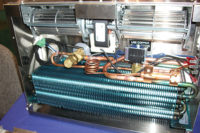Sometime later, the same problem crops up. So again you fix it.
Once again, same problem.
Now you face a dilemma. Do you fix it again? Or do you seek help to find out exactly what is going wrong and why?
It’s a problem many contractors face. Here’s how one such situation was handled.
Finding a Solution
The folks at Susquehanna Radio Corp. in San Francisco, CA, sought help after experiencing four condenser coil leaks in seven years.The company turned to Exponent Failure Analysis Associates of Menlo Park, CA. The company had the condenser in question removed and replaced with a new one. The old unit was taken to its labs.
The first step was to run a pressure leak test to 250 psig with a water-and-soap solution. A leak was found in the uppermost tube on the backside of the coils near the third tube sheet.
The leaking area was then cut from the condenser for further examination. Tubes were numbered and it was determined that tube 1, the closest to the back and nearest the top, had the leak.
Next, the interior of tube 1 was inspected with a borescope. That inspection revealed a circumferential crack corresponding to the location of the steel tube sheet. In addition, a number of tubes, including tube 1, exhibited interior dents. Borescope exams of the other dented tubes showed no cracks.
Tubes 1 and 2 were then cut from the cross section. The aluminum fins were removed, exposing the outside surface of the copper tubes. Removal of the tube sheet confirmed the results of the borescope exam, that the dent and crack in tube 1 corresponded to the tube sheet location along the tube length.
Next came a microscopic exam of tube 1. That showed a through-the-wall circumferential crack that extended nearly 180 degrees. The exterior of tube 1 at the crack location showed evidence of wear in addition to the dent. According to the analysis, “The dent and wear suggest that tube 1 interfered with the steel tube sheet.”
Next, a section of tube 1 was broken open to expose the fracture surface for further exam under a screening electron microscope. Again the fracture surface extended for nearly 180 degrees or halfway around the circumference of tube 1. This exam was done to determine what might have caused the crack that led to the leak.
‘Intergranular Cracking’
That research suggested “that intergranular cracking initiated from the outside diameter and grew inward over time until eventually the operating load exceeded the fracture strength of the remaining wall thickness.”The report contended this type of cracking could result from a corrosive environment and/or “residual stress created during fabrication,” the latter possibly taking place during the manufacturing process.
Dirk Duffner, senior engineer at Exponent Failure Analysis Associates, said such research allows the customer and contractor information needed to possibly avoid such problems in the future.
If corrosion is a problem, alternative tubing in a potentially corrosive environment could be considered. If there was a problem in the manufacturing, the vendor could be notified and the findings could be factored into future quality control considerations.
For more information, contact Exponent Failure Analysis Associates, 149 Common-wealth Drive, Menlo Park, CA 94025; 650-688-7184.
Publication date: 01/29/2001


